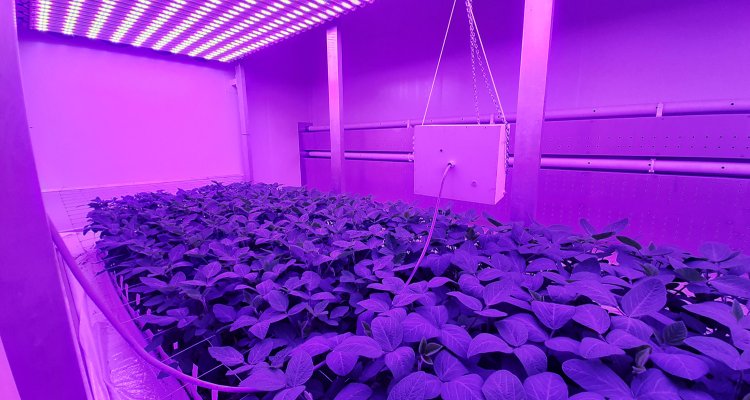
News
Can soybeans be grown in a protected environment?
In principle, essential macronutrients of the human diet, like protein, could technically be produced in controlled environment agriculture (CEA). This aspect becomes relevant in the era of protein transition, marked by an increasing consumer interest in plant-based protein and environmental challenges faced by conventional farming. However, the real question is: what does the indoor cultivation of protein crops imply in terms of resource use? To address this, a study was conducted by the Greenhouse Horticulture and Flower Bulbs Business Unit of Wageningen University & Research using a vertical farm experiment focusing on two soybean cultivars. The results were published early this year.
Protein crops (such as legumes) for human consumption and animal feed are mainly grown in open fields. Compared with major arable crops (e.g. wheat), legumes deliver ecological benefits to cropping systems (such as improved soil quality and fertility). On the other hand, there are many drawbacks associated with open-field cultivations such as high water and land use, erratic yields due to unfavorable climatic conditions and susceptibility to pests and diseases. Controlled environment agriculture, such as greenhouses and vertical farm systems, is less (or not at all) dependent on the outdoor climate, allows growth factors to be steered (depending on the degree of technology implemented) and crop responses to be studied.
WUR investigated whether soybeans can be grown indoors, under controlled conditions, and if so: how and with what resources. For the study, two soybean cultivars were grown in two double-layer cells of an experimental vertical farm (Bleiswijk, NL).
Soybean (Glycine max L. Merr.) was chosen as reference crop because, among the plant-based protein sources, it has the highest protein content and a quality closest to animal proteins.
With a variable plant density to optimise area use, and because of the ability to have more crop cycles per year, protein yield per square meter of crop was about eight times higher than in the open field. Assuming soy as the only protein source in the diet, the resources needed to get total yearly protein requirement of a reference adult would be 20 m2 of crop area, 2.4 m3 of water and 16MWh in the VF, versus 164 m2, 111 m3 and 0.009 KWh in the field.
While the vertical farm allows for a substantially more efficient use of soil area and water for protein production compared to traditional open fields, this advantage is counterbalanced by notably higher electricity consumption, for both lighting (which is naturally provided in the field) and climate control.
Researcher Isabella Righini: “The cultivation of soybeans in a vertical farm is not commercially feasible, but this did not come as a surprise. Given current electricity prices (as well as product prices), it is unlikely to justify the production of simple protein crops in such a system. However, this study was a necessary step to collect baseline data on yield and resources of a protein crop, and for this purpose, a vertical farm is an excellent research tool. The study lays the foundation for future research into the cultivation of soybeans in CEA systems that take advantage of (freely available) sunlight, such as greenhouses”.